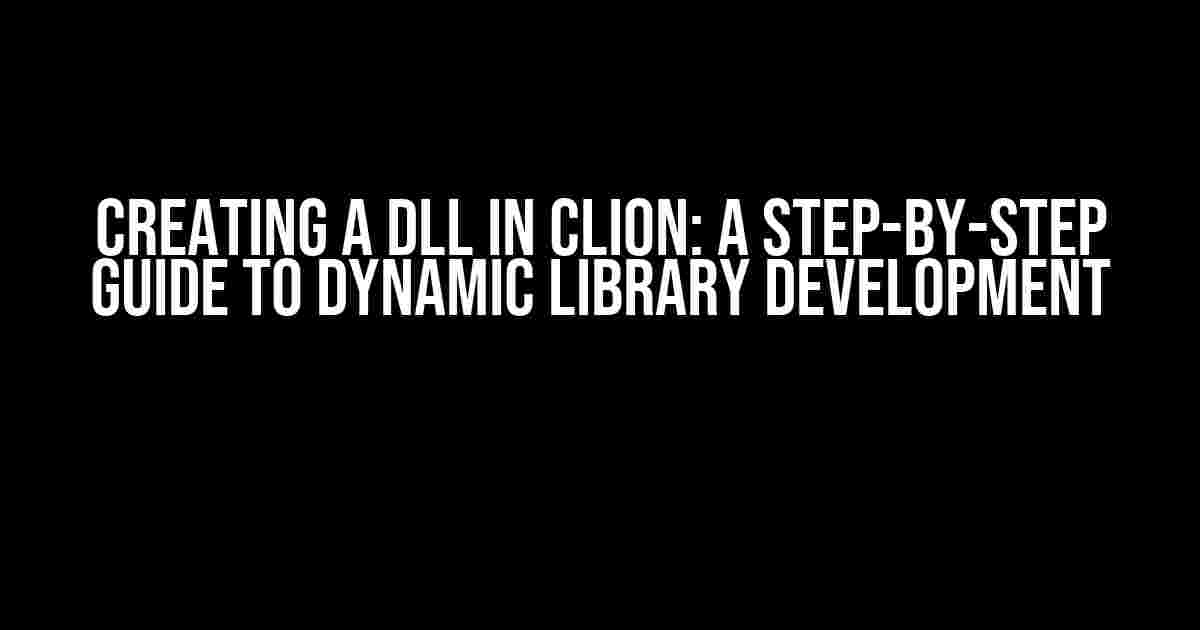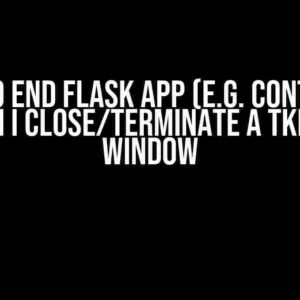Are you ready to take your C++ development skills to the next level? Do you want to learn how to create a Dynamic Link Library (DLL) in CLion? Well, you’ve come to the right place! In this comprehensive guide, we’ll take you through the process of creating a DLL in CLion, from setting up your project to exporting your library. Buckle up, and let’s get started!
What is a Dynamic Link Library (DLL)?
A Dynamic Link Library (DLL) is a type of library that contains a set of functions and variables that can be used by multiple applications. DLLs are essential in software development, as they allow developers to modularize their code, reduce duplication, and improve code reuse. In Windows, DLLs are used extensively by applications, frameworks, and even the operating system itself.
Why Create a DLL in CLion?
CLion is a popular cross-platform IDE developed by JetBrains. It offers a comprehensive set of tools for C++ development, including project templates, code completion, debugging, and testing. Creating a DLL in CLion is an excellent way to leverage the IDE’s features and create reusable code that can be shared across multiple projects.
Creating a New Project in CLion
To create a new project in CLion, follow these steps:
- Open CLion and click on “New Project” in the start page.
- In the “New Project” dialog, select “C++” as the project type.
- Choose “Dynamic Library” as the project template.
- Enter a project name, such as “MyDLL”, and specify the project location.
- Click “Create” to create the new project.
Configuring the Project Settings
After creating the new project, you’ll need to configure the project settings to compile and link your DLL correctly. Follow these steps:
- In the project settings, navigate to “CMake” section.
- In the “CMakeLists.txt” file, add the following lines to specify the DLL output:
- Save the changes to the “CMakeLists.txt” file.
cmake_minimum_required(VERSION 3.10)
project(MyDLL)
set(CMAKE_WINDOWS_EXPORT_ALL_SYMBOLS TRUE)
set(CMAKE_SHARED_LIBRARY_LINK_C_FLAGS "${CMAKE_SHARED_LIBRARY_LINK_C_FLAGS} /DLL")
set(CMAKE_SHARED_LIBRARY_LINK_CXX_FLAGS "${CMAKE_SHARED_LIBRARY_LINK_CXX_FLAGS} /DLL")
add_library(MyDLL SHARED MyDLL.cpp)
Writing the DLL Code
Now that the project is set up, it’s time to write the DLL code. In this example, we’ll create a simple math library that exports two functions: `add` and `subtract`.
// MyDLL.h #ifndef MYDLL_H #define MYDLL_H #ifdef MYDLL_EXPORTS #define MYDLL_API __declspec(dllexport) #else #define MYDLL_API __declspec(dllimport) #endif MYDLL_API int add(int a, int b); MYDLL_API int subtract(int a, int b); #endif // MYDLL_H
// MyDLL.cpp
#include "MyDLL.h"
MYDLL_API int add(int a, int b) {
return a + b;
}
MYDLL_API int subtract(int a, int b) {
return a - b;
}
Building and Exporting the DLL
To build and export the DLL, follow these steps:
- In the CLion menu, go to “Build” > “Build Project” to compile the DLL.
- Once the build is complete, navigate to the project directory and find the generated DLL file (e.g., “MyDLL.dll”).
- To export the DLL, create a new folder (e.g., “lib”) and copy the DLL file into it.
- In the “lib” folder, create a new file called “MyDLL.lib” and add the following content:
- Save the changes and close the file.
LIBRARY MyDLL
EXPORTS
add
subtract
Using the DLL in Another Project
To use the DLL in another project, follow these steps:
- Create a new C++ project in CLion.
- In the new project, add the DLL’s include directory to the project settings:
- In the new project, add the DLL’s lib file to the project settings:
- In the new project, include the DLL’s header file and use the exported functions:
| Setting | Value |
|---|---|
| CMAKE_INCLUDE_PATH | path/to/MyDLL/include |
| Setting | Value |
|---|---|
| CMAKE_LIBRARIES | path/to/MyDLL/lib/MyDLL.lib |
#include "MyDLL.h"
int main() {
int result = add(2, 3);
std::cout << "Result: " << result << std::endl;
return 0;
}
Conclusion
And that's it! You've successfully created a DLL in CLion and used it in another project. Creating a DLL can seem daunting at first, but with the right tools and a clear understanding of the process, it's a breeze. With CLion, you can create, build, and export DLLs with ease, making it an essential skill for any C++ developer.
Best Practices and Tips
Here are some best practices and tips to keep in mind when creating a DLL in CLion:
- Use a clear and descriptive naming convention for your DLL and its exported functions.
- Use the `__declspec(dllexport)` and `__declspec(dllimport)` directives to specify the DLL's export and import behavior.
- Keep your DLL's header file separate from its implementation file to ensure modularity and code reuse.
- Use a versioning system to track changes to your DLL and ensure backward compatibility.
- Test your DLL thoroughly before releasing it to ensure it works correctly in different environments.
With these tips and best practices in mind, you'll be well on your way to creating robust and reusable DLLs in CLion. Happy coding!
Frequently Asked Question
Get ready to unlock the secrets of creating a DLL in CLion! Here are the top 5 questions and answers to get you started:
Q1: What is a DLL, and why do I need to create one in CLion?
A DLL (Dynamic Link Library) is a library of reusable code that can be linked to multiple programs, allowing you to modularize your code and reuse it across different projects. Creating a DLL in CLion allows you to write and compile your code in a separate project, making it easier to manage and maintain large-scale applications.
Q2: What are the benefits of creating a DLL in CLion?
Creating a DLL in CLion offers several benefits, including code reuse, improved performance, and easier maintenance. By separating your code into modules, you can update or modify individual modules without affecting the entire application. Plus, DLLs can be used across different programming languages and platforms, making them a versatile tool in your development arsenal.
Q3: How do I create a new DLL project in CLion?
To create a new DLL project in CLion, go to File > New Project, and select "Dynamic Library" as the project type. Then, choose the language and platform you want to use, and follow the prompts to set up your project. CLion will generate a basic DLL project structure, including a header file, source file, and build settings.
Q4: How do I compile and build my DLL in CLion?
To compile and build your DLL in CLion, you'll need to configure your build settings and compile your code. Go to Settings (or Preferences on Mac) > Build, Execution, Deployment > CMake, and specify the build type (e.g., Debug or Release) and compiler settings. Then, click the "Build" button or press Shift+F9 to compile and build your DLL.
Q5: How do I use my DLL in another CLion project?
To use your DLL in another CLion project, you'll need to link the DLL to your new project. Add the DLL file to your new project's directory, and then go to Settings (or Preferences on Mac) > Build, Execution, Deployment > CMake, and add the DLL to your project's link libraries. Finally, include the DLL's header file in your code, and you're ready to go!



